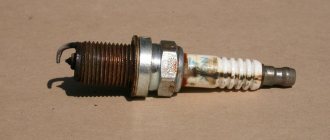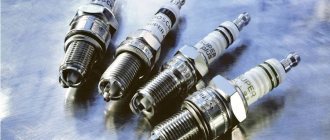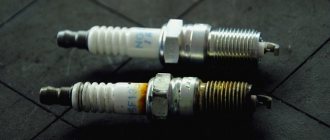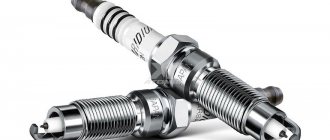Photo No. 1 shows a spark plug removed from an engine whose performance can be considered excellent. The skirt of the central electrode is light brown in color, soot and deposits are minimal. Complete absence of oil traces. The owner of this engine can only be envied, and there is something to be said for its economical fuel consumption and the absence of the need to add oil from replacement to replacement.
Photo No. 2 shows a typical example of a spark plug from an engine with high fuel consumption. The central electrode is covered with velvety black soot. There are several reasons for this: a rich air-fuel mixture (incorrect carburetor adjustment or injector malfunction), clogged air filter.
The third photo, on the contrary, is an example of an excessively lean air-fuel mixture. The color of the electrode is from light gray to white. There is cause for concern here. Driving with a too lean mixture and under increased loads can cause significant overheating of both the spark plug itself and the combustion chamber, and overheating of the combustion chamber is a direct path to burnout of the exhaust valves. Skirt of the central electrode of the spark plug shown in the photo
No. 4 has a characteristic reddish tint, this color can be compared to the color of red brick. This redness is caused by the engine running on fuel containing an excessive amount of metal additives. Long-term use of such fuel will cause metal deposits to form a conductive coating on the insulation surface, through which it will be easier for current to pass than between the electrodes of the spark plug, and the spark plug will stop working.
Photo No. 5. The candle has pronounced traces of oil, especially in the threaded part. An engine with such spark plugs after a long period of parking tends to “triple” for some time after starting, and as it warms up the operation stabilizes. The reason for this is the unsatisfactory condition of the oil seals. There is increased oil consumption. In the first minutes of engine operation, at the moment of warming up, there is a characteristic white and blue exhaust.
The spark plug in photo No. 6 was removed from a non-functioning cylinder. The central electrode and its skirt are covered with a dense layer of oil mixed with drops of unburnt fuel and small particles from the destruction that occurred in this cylinder. The reason for this is the destruction of one of the valves or the breakage of the partitions between the piston rings with metal particles getting between the valve and its seat. In this case, the engine “troubles” incessantly, a significant loss of power is noticeable, fuel consumption increases by one and a half, two times. There is only one way out - repair.
Photo No. 7 is a complete destruction of the central electrode with its ceramic skirt. The cause of this destruction could be one of the following factors: prolonged operation of the engine with detonation, the use of low octane fuel, very early ignition, and simply a defective spark plug. The engine operating symptoms are the same as in the previous case. The only thing you can hope for is that the particles of the central electrode managed to slip into the exhaust system without getting stuck under the exhaust valve, otherwise repairing the cylinder head cannot be avoided. But it depends on the person, whether he is sinful or not (just kidding). If we talk about this particular candle, then God had mercy on its owner.
Photo No. 8 is the last one in this review. The spark plug electrode is overgrown with ash deposits; the color does not play a decisive role, it only indicates the operation of the fuel system. The reason for this build-up is the combustion of oil due to wear out or jamming of the oil scraper piston rings. The engine has increased oil consumption, when over-gasping, there is strong blue smoke from the exhaust pipe, and the smell of the exhaust is similar to that of a motorcycle. If you want to have fewer problems with the operation of your engine, do not think about spark plugs only when the engine refuses to work. The manufacturer guarantees trouble-free operation of the spark plug on a working engine for 30 thousand kilometers. But you, in turn, do not forget to check the condition of the spark plugs with every oil change or on average every 10 thousand kilometers. First of all, this is adjusting the gap to the required value and removing carbon deposits. It is better to remove carbon deposits with a metal brush; sandblasting destroys the ceramics of the central electrode, and you risk getting a copy of photo No. 7. I would also recommend swapping spark plugs, this is due to different temperature conditions of the cylinders.
What can you tell by the color of the spark plugs when checking?
Spark plugs are the most important part that is necessary for the operation of a gasoline engine. The main task is the formation of a spark in the combustion chamber, due to which it is possible to ignite the fuel-air mixture in the cylinder.
Note that any disturbances in the spark formation process lead to the engine beginning to lose power, increased fuel consumption, slower reactions to pressing the gas pedal, the power unit begins to operate unstably, troits, has toxic exhaust, etc.
At the same time, for experienced car enthusiasts and professional auto mechanics, diagnostics based on the color of spark plugs is a reliable way to determine the condition of the entire engine and identify possible problems and failures. The fact is that these elements are located in the combustion chamber and are a kind of indicator of the condition of the internal combustion engine.
Such knowledge can be useful both when checking the spark plugs themselves or in the process of searching for various engine faults, and when buying a used car with an unknown history. Next, we will look at what the correct color of spark plugs should be, as well as what color of spark plugs means what and what engine failures indicate in a particular case.
Read in this article
The most common mistakes
In order for the diagnostic results to be as reliable as possible, it is necessary to evaluate the condition of the spark plugs after prolonged activity of the power unit. In other words, you need to let the engine run longer before you start inspecting the spark plugs. If this is not done, then it will not be possible to correctly diagnose the causes of malfunctioning internal combustion engine.
Often in winter, motorists, starting a cold engine, hear extraneous noises indicating uneven operation, and immediately after this they begin to inspect the spark plugs.
It should be remembered that this approach is incorrect, since black soot, which is likely to be found on the spark plugs, only indicates an excessive enrichment of the fuel mixture, which is quite normal in conditions of negative temperatures. Carbon deposits when the engine is not warmed up.
This phenomenon is explained quite simply.
Until the engine is warmed up, incomplete combustion of the fuel mixture will be observed, while unstable engine operation may be caused by failure of the explosive wires. To correctly diagnose engine behavior that is out of the norm, you need to screw in known good spark plugs into it and drive a distance of at least 200 km. This will eliminate the possibility of an erroneous conclusion.
Different colors of spark plugs: what does it indicate?
As already mentioned, the appearance of the spark plug allows you to evaluate the quality of operation and general condition of the entire engine, as well as its individual components and mechanisms. Let us immediately note that you need to start inspecting the spark plugs only after the engine has warmed up well and reached operating temperatures, and has also worked under load before the inspection.
- So, let's look at the meaning of the colors of spark plugs, which can be seen after they are unscrewed on various internal combustion engines. Let's start with the fact that the normal color of a spark plug is when the skirt of the central electrode is light brown, there is practically no soot and various deposits. There should also be no visible oiling. This color of working spark plugs indicates the efficiency of the engine, the completeness of combustion of the mixture in the cylinders, and the absence of oil consumption due to wear on the timing belt or CPG.
- If, after unscrewing, it is clear that black fluffy carbon deposits have accumulated on the central electrode, then this indicates problems with the engine power supply system or the intake air supply. As a result, the engine runs on a rich mixture and overuses fuel. The reason may be the need for additional carburetor adjustments, injection malfunctions, or dirty air filter.
- If the spark plug electrode is covered with a grayish light soot or white coating, then this color indicates that the engine is running on too lean a mixture of fuel and air.
- If it is noticeable that the central electrode of the spark plug and the skirt are covered with engine oil, and also unburned fuel is found on the spark plug, then the cylinder from which the spark plug was unscrewed does not work, and the spark plug itself is flooded. As a rule, in this case the engine noticeably stalls, loses power, and overuses fuel. There can be many reasons for this, ranging from a malfunction of the spark plug or ignition system to serious breakdowns in the engine (low compression, valve burnout, destruction of piston rings, etc.). The most alarming sign can be considered the presence of small metal particles that stick to the oily soot. This indicates destruction or significant wear of any part or element, after which metal fractions entered the combustion chamber. In such a situation, the engine must be disassembled, troubleshooted and then repaired.
- Obvious destruction of the central electrode and its ceramic skirt will indicate that the engine has been running for a long time under detonation conditions, the ignition is set early, fuel with an inappropriate octane number is used for a particular type of internal combustion engine, or the spark plug has poor workmanship, a defect or a manufacturing defect.
What color is considered normal?
The performance of the gasoline power unit is indicated by spark plug electrodes painted in a light brown tint, without oil deposits and soot. A similar picture is observed in completely new engines and engines that have undergone a major overhaul.
If the color of the working part differs from the specified one, it is advisable to carry out further diagnostics and identify the cause of the problem. Moreover, the engine itself is not always the culprit. What color options are there for spark electrodes:
- light gray or white;
- black;
- brick or frankly red tint.
In addition to all sorts of colors, the candle skirt is covered with various deposits - soot, brown soot, or may simply look wet. These phenomena are also considered signs of various malfunctions. It is proposed to consider each situation in more detail.
Useful tips
Having figured out what color the spark plugs should be in a given case, you can diagnose the internal combustion engine. We would also like to add that it is very important to follow the rule that before removing the spark plugs, the engine must warm up and operate under load.
As already mentioned, to obtain reliable data, before removing the spark plugs, you need to drive the car about 30, or even better, two or even three hundred kilometers, along the highway. If the condition of the engine is of concern and you need to diagnose the spark plugs and their color, then the following actions would be the most correct:
- select new spark plugs that correspond to the recommended physical dimensions and heat rating for a specific internal combustion engine;
- refuel with high-quality fuel at a proven gas station;
- after installing the spark plugs, go on a trip along the highway, which will cover a distance of at least 30 to 300 km;
Only after these steps can you unscrew the spark plugs, after which you can judge the operation of the internal combustion engine based on their color, soot and condition. It should also be taken into account that in the CIS the quality of fuel is significantly inferior to that in European countries. It turns out that the declared service life of any spark plugs, regardless of type, brand, design features (iridium, multi-electrode, platinum, etc.), as well as other differences, is desirable to be reduced by 20-30%.
In this case, a more important indicator is not what color the spark on the candle should be, but the discharge power and breakdown depth. At the same time, it is recommended to check the spark plug for performance under conditions of high pressure in the combustion chamber. There are special stands for such a test, since there are quite common cases when during a normal test there is a spark, but after screwing it into the engine certain malfunctions occur.
The working part is covered with black soot
Black spark plugs are a symptom indicating that the fuel mixture is too rich (the proportion of gasoline is increased above normal). Therefore, the fuel does not burn completely and forms a layer of soot on the chamber walls and spark plug electrodes.
An additional sign of this problem is black or dark gray smoke from the exhaust. When over-gassing, small flakes of soot may fly out of the pipe.
There are quite a few reasons for the enrichment of the air-fuel mixture, the most common ones look like this:
- One of the key sensors has become unusable - air flow, temperature, throttle position or oxygen content in the exhaust (lambda probe). The controller activates the emergency program and prepares the mixture according to other indications.
- Carburetor malfunctions (clogged air jets, worn throttle valves, etc.).
- Failure of the pressure regulator in the fuel line.
- Wear of nozzles - nozzles “overflow” and leak when the power unit is not working.
- Problems with sparking - the power of the electrical pulse is not enough to ignite the combustible mixture normally.
Important! If during the diagnostic process you find black spark plugs, the fault should be found immediately. Increased gasoline consumption is only part of the consequences of excessive enrichment.
There are others, not so harmless:
- some of the unburned fuel penetrates the crankcase and dilutes the oil, accelerating the wear of engine parts;
- the other part gets into the exhaust manifold, which is why shots are periodically heard in it;
- soot clogs the expensive catalytic converter - it has to be cleaned or replaced with a new one;
- The service life of the spark plugs is sharply reduced.
Diagnostic methods
When the normal color of spark plugs (SZ) is lost and darkening appears in the form of carbon deposits, such an event can appear both on one side and along the entire diameter. Problems are possible in a single cylinder at the same time or can appear in several places at the same time. Also, experienced motorists are able to distinguish the so-called types of dry or wet carbon deposits.
It is worth considering the factors on which the occurrence of multi-colored deposits depends:
- The first signs of a dark coating on the surface of new SZ can often appear after 200-300 km of run. The phenomenon can be monitored when driving along the highway for a long time at a constant speed and load on the internal combustion engine. In this way, it will be possible to obtain objective information about their condition.
- The amount of dark deposits on the surface depends on the quality of gasoline. This forces motorists to look for gas stations that offer high-quality fuel, and under no circumstances fill in gasoline or similar liquids.
- For carburetor engines, it is recommended to control the set idle speed.
The use of additives helps prevent the appearance of black burning.
Types of soot
Diagnostic operations can be carried out independently, based on the instructions for replacing spark plugs. It is advisable to carry them out regularly to monitor the condition of the fuel system elements. Otherwise, the car will behave negatively while driving, for example, there will be vibrations in the engine compartment, intermittent power, etc.
It is important to know what color spark plugs should be in order to fully perform their functions, because unnecessary deposits that hide shiny metal contact surfaces prevent a spark from appearing regularly at the right moment.
Before you find out what the color of spark plugs means, you need to understand what varieties there are. The following colors are found in cars:
The final color is determined by the chemical composition of the combustion mixture. An ideal working candle would be one that does not have a coating or has small whitish salt deposits, resulting in the formation of a gray film . Also, in addition to shades, there should not be a high density of soot, which often appears in the following cases:
- low quality fuel;
- problems working with filters;
- defective equipment from unscrupulous manufacturers;
- discrepancy between the physical characteristics of spark plugs and internal combustion engines.
Once the causes are identified, it is worth getting rid of them as soon as possible.
White deposits on spark plugs: causes
As a rule, most motorists with little experience expect to notice a tarry coating on the surface after unscrewing spark plugs from the combustion chamber. However, in almost every fifth case its color turns out to be whitish.
It is believed that white carbon deposits on spark plugs are evidence of poor fuel quality. It can also indicate a reduced percentage of gasoline in the prepared mixture. When this type of by-product has some tactile roughness, this is a sign of frequent overheating of the internal combustion engine.
If the main reason is dirty gasoline, then it is enough to change the gas station and clean the contacts for better spark formation. In the second case, you will need to perform some diagnostic work to identify the source of overheating that occurs in such situations:
- depressurization of the intake manifold, as a result of which more air penetrates into the mixture;
- spark plugs installed that are not suitable for this engine;
- there were problems with the cooling system;
- Radiator malfunctions;
- Ignition calibration is required.
A similar yellow tint occurs due to the high temperature in the combustion chamber. It manifests itself during engine operation at elevated or maximum possible speeds. We recommend that the driver shift gears in advance, at 4-5 thousand rpm, avoiding unreasonable warming up.
Other signs of trouble
The following symptoms, which you can identify after unscrewing the spark plugs, will tell you about future and current problems with the engine:
- Motor oil can be seen on the threaded tip and area near the outer electrode.
- The working part protruding into the combustion chamber is covered with fluffy brown soot.
- The candle is frankly wet, and there is a strong smell of gasoline.
- The internal electrode is burnt or missing.
When there is a small amount of liquid oil on the spark plug, you should think about checking the cylinder-piston group . The lubricant penetrates through the oil scraper rings, entering the chamber with each cycle and upward movement of the piston, so it does not burn. As a rule, such an effect indicates the initial stage of wear of the compression and oil scraper rings.
The light brown color of the coating means that the engine consumes a large amount of lubricant due to waste. Moreover, the oil penetrates along with the combustible mixture through the opening valves. The fact is confirmed by the fact that the lubricant completely burns out and is deposited on the walls, since it enters the chamber only during the intake cycle. The reason is critical wear of the oil seals (otherwise known as valve seals). An additional sign is high oil consumption, amounting to 0.5–1 liters per 1 thousand kilometers.
A wet spark plug that smells of gasoline was probably unscrewed from a non-functioning cylinder. The second option is complete failure of the spark plug itself. Gasoline is regularly supplied into the chamber by an injector, but does not ignite and partially flows into the crankcase. If there is no compression in the cylinder, then compression and subsequent flash do not occur - fuel is wasted (consumption reaches + 25%) and dilutes the engine lubricant.
Reference. An idle cylinder is clearly audible at any engine speed - the engine desperately “troubles” and has difficulty starting when cold.
Obviously, a spark plug with a burnt-out electrode must be replaced. An important nuance: these parts are not replaced one at a time, but only in sets of 4 pieces. It is allowed to place a working spark plug in the cylinder temporarily - to get to the garage or service station.
To diagnose a car engine, you can use different methods: compression measurements, computer diagnostics, and much more help to assess the condition of the engine. However, such methods require the use of special tools, which are not always at hand.
However, experienced car owners know how to determine the proper operation of the internal combustion engine without the use of additional equipment. You can make a correct diagnosis by examining the carbon deposits on the spark plugs.
Red soot
If red spark plugs appear after unscrewing, then this type will turn out to be low-risk in most cases. The tonality of the surface appears in half of the cases and is explained by the presence of active impurities or additives in the mixture, which, for example, contribute to better combustion of the composition or protection from possible corrosion processes.
The presence of reddish-red tones is a sign of a large amount of fuel and the presence of oily elements in the mixture. The saturation of burgundy is a case associated with low-quality gasoline, which contains an abundance of improving additives. Light similar tones correspond to better quality gasoline.
If you detect a similar tone on the surface of the spark plug, you should not go to repair the car. It is enough to change the spark plugs, change the oil and refuel at another gas station.
Black soot
This type of soot is one of the most dangerous. If you detect signs of soot on the surface of the spark plugs, we recommend that you undergo diagnostics at a car service center to accurately find out the condition of the car.
An abundance of black particles occurs when there is a problem with the motor in 90% of cases. Their presence indicates an excess of fuel volume in the resulting mixture, which contributes to rapid wear of the main components and mechanisms of the internal combustion engine. Experienced specialists assure that the presence of this kind of contamination indicates not only engine imbalance, but also problems with the engine.
Traditionally, there are two types of soot:
In the first option, there is an imbalance in the proportions of fuel and air, which is a consequence of the following processes:
- carburetor failure or clogging;
- problems with the enrichment agent;
- decreased air filter permeability, which leads to insufficient penetration of air into the mixture;
- reduced compression;
- problems with spark plugs leading to unstable sparking.
In the second option, if oily contaminants with black-brownish tints are detected, there is a high probability of engine oil penetrating into the combustion chamber. Inside the cylinder, the lubricating fluid does not completely burn out due to its physical and chemical properties and insufficient flammability. Penetration occurs in most cases due to deterioration of the piston rings and valve caps.
What does the color of spark plugs mean?
Some useful information about spark plugs taken from the Internet. Many people know this, of course, but some will find it useful.
What can an inverted candle and its color say?
There are many ways to diagnose the condition of a car engine. Among the most frequently used are computer diagnostics, compression measurement and others, but most of them require special equipment. However, there is a sign by which you can quite accurately determine how well the engine is working, without the use of additional tools - this is carbon deposits on the spark plugs. The appearance of a turned-out spark plug can tell a lot about the condition of the power unit and the correct operation of the auxiliary systems.
Common mistake
To obtain a reliable result, the inspection must be carried out after the engine has been running for a long time. Otherwise, the inspection result will allow you to draw erroneous conclusions. Quite often there is a situation when drivers start a cold engine in winter and, hearing the sound of its uneven operation, turn off the spark plugs and turn them out. Seeing black carbon deposits, they draw premature conclusions about the malfunction of the power unit, forgetting that black carbon deposits can form due to the fact that at subzero temperatures the working mixture is forcibly enriched, and due to the fact that the engine is not warmed up to the optimal temperature, it does not have time to burn completely . Unstable operation may well be explained by a malfunction of high-voltage wires that need to be replaced long ago.
How to do it right
Thus, in order to get a reliable result, it is best to drive at least two hundred kilometers on obviously clean, serviceable spark plugs. In this case, the possibility of error is almost completely eliminated.
Based on the state of the spark plug, you can determine how far the car has traveled since the last replacement. Of course, the calculation is approximate; the initial data is taken to be that the distance between the electrodes of a standard spark plug increases by 0.015 mm with every thousand kilometers traveled. The service life of conventional spark plugs is usually small and amounts to 30 thousand kilometers. In stores, multi-electrode ones are offered as an alternative. They have two advantages: increased resource (about 60 thousand km); uniform propagation of the flame front in the cylinder, regardless of how the spark plug is screwed in.
Many modern cars use iridium or platinum spark plugs. They are distinguished by a thin central electrode (about 0.4 mm). They have to be changed every hundred thousand kilometers, and thanks to the small diameter of the central electrode, a spark is formed in almost the same place, with the same force.
Soot color on spark plugs
Normal condition
If everything is in order with the car engine, then there will be few deposits on the insulator, and its color can vary from light brown to coffee. There cannot be any traces of oil on the spark plug. The electrode burns out moderately. In the case of an iridium spark plug, even burnout will most likely go unnoticed. Any other color and condition of the candle is a deviation from the norm and requires increased attention.
Black
If the insulator and electrodes are covered with velvety black soot, this indicates that the power system is preparing an excessively rich mixture. The extent of the carbon deposits indicates the degree of over-enrichment of the working mixture. The reasons lie in the fact that the carburetor is incorrectly adjusted, or there is a malfunction in the electronic control unit of the injection engine (for example, the air filter is clogged, the oxygen sensor is faulty, or the air damper drive mechanism is faulty). This phenomenon is accompanied by increased fuel consumption.
Light grey, white
A light gray or white color of the insulator indicates that the engine, on the contrary, is running on an excessively lean mixture. If measures are not taken to correct the problem in a timely manner, overheating or melting of the spark plugs, or overheating of the combustion chamber will follow, which will subsequently lead to burnout of the exhaust valves. The reasons for the appearance of such deposits can be different: the heat rating is too low (a “hot” plug), the use of low-octane gasoline, or too much ignition timing. It is also necessary to pay attention to whether such a phenomenon as glow ignition manifests itself, if it occurs, therefore, the spark plugs overheat during operation.
Brown, red
Brown or red soot on the insulator, comparable to the color of red brick, appears due to the engine running on gasoline containing compounds of lead or other metals. These compounds are added to fuel in the form of additives to increase the octane number. If the engine has been running on leaded gasoline for a long time, a brown conductive coating forms on the surface of the insulator, resulting in the disruption of normal sparking.
Oil on candles
The next option is carbon deposits with traces of engine oil on the spark plug. As a rule, after a long period of parking, the engine stalls for the first time after starting, and the exhaust gases have a white-blue color. After warming up, all symptoms disappear. The picture is completed by increased oil consumption. Such signs indicate incorrect temperature conditions in the cylinder. The reasons for the formation of oily carbon deposits are a too “cold” spark plug (with a high heat rating), wear of the piston rings, valve stem seals or valve guides.
It may also happen that an inverted spark plug will have neither a central electrode nor an insulator at all. This occurs as a result of prolonged operation of the engine with detonation, the use of low-octane gasoline, too early ignition or manufacturing defects. Associated symptoms are similar to the case described above. If the circumstances are successful, the fragments of the electrode and insulator will get into the exhaust system and will not get stuck between the valve and the seat, otherwise the cylinder head will need to be repaired or replaced.
Ash deposit
The candle may be covered with ash deposits; their color does not matter (carbon deposits can be white, gray or black). This occurs due to oil entering the combustion chamber. The reasons for the formation of such deposits are stuck rings or worn-out cylinders. As accompanying symptoms, there is increased oil consumption, a strong blue exhaust with a characteristic odor, similar to a motorcycle.
Erosion
When the spark plugs are used for a long time without replacement, traces of erosion noticeably appear on the side and central electrodes; the insulator may have a white, brown or coffee color. The car's engine continuously stalls, does not develop full power, and idles unstably. The reasons for this are failure to comply with spark plug replacement intervals or the use of gasoline containing tetraethyl lead. Lead compounds cause chemical reactions in the cylinder, resulting in rapid destruction of the electrodes.
Gasoline on spark plugs
Finally, the last case is when the turned-out spark plug turns out to be filled with gasoline. If it is not unscrewed immediately after starting the engine in cold weather, this indicates that the ignition system, carburetor or injector is faulty. You can try to blow out and dry the spark plug; if the pattern repeats, you will have to do some repairs.
Light electrodes
White or light gray spark plugs in all cylinders are a sign of a lean air-fuel mixture supplied by the injector or carburetor. Moreover, the skirt, area near the electrodes and the threaded part are absolutely dry, without traces of oil.
Why is the fuel mixture supplied lean?
- lambda - the probe incorrectly informs the control unit about the amount of oxygen in the exhaust gases, the reason is sensor wear;
- faulty or clogged nozzles;
- incorrect carburetor settings or clogged fuel jets;
- insufficient pressure in the injector fuel rail;
- problems with the idle air control;
- air leakage under the manifold or in another place;
- unsuccessful chip tuning of the controller made by the owner of the car.
A lean mixture does not pose any particular danger to a running engine, but it does cause discomfort to the driver. The car accelerates slowly, pulls poorly and jerks - there is a lack of fuel. Oddly enough, the phenomenon causes increased gasoline consumption - a car enthusiast who wants to achieve better performance indicators presses the accelerator pedal harder and more often.
Note. Often the light shade of the working electrodes is explained by the type of fuel used. If the car is operated on methane or liquefied gas (propane-butane mixture), this color is considered normal.











